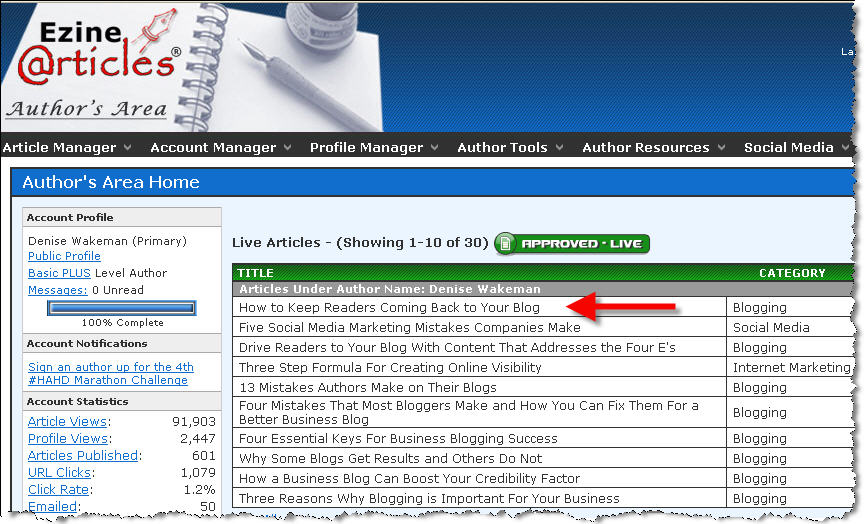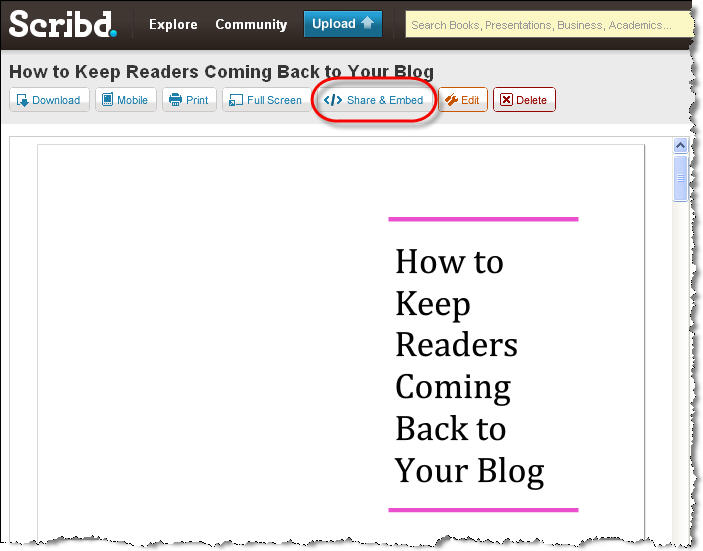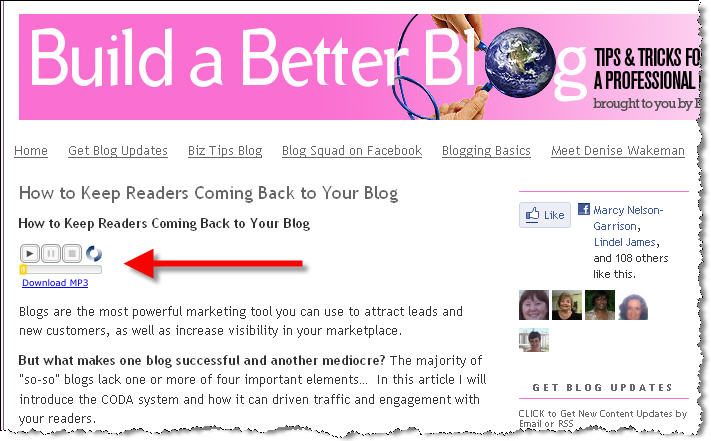 How many ways are you leveraging your blog posts?
How many ways are you leveraging your blog posts?
Most people write a post and that’s the end of it. You’re probably syndicating your blog feed to the usual places: Facebook, Twitter and LinkedIn, at the very least. And that’s a good thing.
Yet there are many other ways to get more mileage out of your content.
As discussed in one of my prior articles, content syndication is just one part of the equation. But to really get the most leverage from your blog, think about how many ways you can repurpose the content (and then syndicate the new formats to all the usual sites).
Repurposing your content means turning your blog posts into different formats like reports, white papers, articles, slide shows, videos, podcasts, teleseminars, ebooks, etc.
Why Repurpose Content?
It may come as a shock, but not all your ideal clients know about or read your blog! There are people in your target audience hanging out on other sites all over the web. People are looking for information to read, share and learn from, and you want them to find you and your solutions.
When you publish content on your blog, you’re most likely providing valuable, relevant information that demonstrates how you solve the problems of your ideal client or customer.
While having that content on your blog is a great place to start, there are many more prospects you can reach by simply repurposing the content in a few ways and distributing that content on other platforms.
You get more exposure and more value from the time you’ve initially invested in creating the content. Not to mention that you can drive more traffic back to your home base.
What You Need to Know
There is some preparation required when repurposing and distributing your content on multiple sites. First, you must set up accounts on the sites you want to use for distribution. Always fill out your profile completely, along with adding your picture when you can.
Also I recommend creating a template you can use to hand this project off to an assistant. For every new post you repurpose, you’ll need to have the following information handy: title, short description and keywords. This should be fairly simple to pull from the original post. Now you’re ready to go.
Let’s look at three simple ways to repurpose your blog posts that don’t require a lot of time or technical know-how: articles, PDFs and audio.
#1: Reformat for Article Directory Sites
This is the simplest and fastest way to repurpose your blog posts.
If your posts are about 500-1000 words, this is a great way to get in front of millions of additional eyeballs. While there are dozens, if not hundreds, of article directory sites, two stand far above the rest and will do the job for you: EzineArticles.com and IdeaMarketers.com.
Get World-Class Marketing Training — All Year Long!
Are you facing doubt, uncertainty, or overwhelm? The Social Media Marketing Society can help.
Each month, you’ll receive training from trusted marketing experts, covering everything from AI to organic social marketing. When you join, you’ll also get immediate access to:
- A library of 100+ marketing trainings
- A community of like-minded marketers
- Monthly online community meetups
- Relevant news and trends updates

Both sites have been around for years, have millions of monthly visitors and are easy to use. Both have the option to upgrade a free account to a paid account so you can get faster approval and featured status, but you can get great exposure without the investment.
When you submit your content, you may want to tweak the title and make sure the content is not overly self-promotional. EzineArticles will reject articles with promotional links in the body.
You’ll also need to create an Author Resource box with contact info, a call to action and a link back to your blog or landing page.
Both sites give you the option to have links to your new articles syndicated to your social sites.
#2: Reformat for Document-sharing Sites
Document-sharing sites cater to those who want to share and read documents as PDF, Word docs or slides. Scribd, for example, has tens of millions of readers every month who read and download documents from the site. The advantage here is that you can embed links and images in your documents, unlike some of the article sites that don’t accommodate images.

Discover Proven Marketing Strategies and Tips
Want to go even deeper with your marketing? Check out the Social Media Marketing Podcast! Publishing weekly since 2012, the Social Media Marketing Podcast helps you navigate the constantly changing marketing jungle, with expert interviews from marketing pros.
But don’t let the name fool you. This show is about a lot more than just social media marketing. With over 600 episodes and millions of downloads each year, this show has been a trusted source for marketers for well over a decade.
Docstoc.com, another popular site, gives you the tools to sell your professional documents as well as give them away for free.
Again, it is super-simple to distribute your content. Copy your blog post into a Word doc; make sure it’s nicely formatted; add your author bio with a call to action and link(s) to your blog, site and/or free reports; then convert to PDF. Upload and you’re done.
A cool feature on some doc-sharing sites like Scribd, Docstoc and others, is the ability to embed your documents on web pages and blogs. This gives readers an easy way to share your content and again extend your reach to new audiences.

Here are three more document-sharing sites:
#3: Record an Audio Version of Your Post
I’m seeing more and more bloggers create audio versions of their blog posts. This is not difficult to do and gives your audience an additional way to consume your wisdom.
Not everyone likes to read, so create a podcast and you extend your reach even further. There are dozens of podcast directories, and of course the heavyweight is iTunes.
About 13% (27 million) of U.S. Internet users listen to podcasts so this is an audience you don’t want to overlook. They may never find your blog, but they’re using iTunes to find content.
You don’t need to be a recording star to create a decent audio of your blog post. I recommend Audacity, for free recording software. You’ll need to host your mp3 audio files on the web and create a podcast feed. Some options are Podbean or Feedburner if you post the audio on your blog.
Once the podcast feed is created, submit it to iTunes (and any other podcast directory you wish). To submit to iTunes, go to the iTunes Store, navigate to the Podcasts directory, and click on the Submit a Podcast link.
The information you’ll need to have on hand when you’re ready to submit your podcast includes: title of your “show” (the collection of audio posts you’ll be creating from your blog), description, keywords, category, and if possible, a graphic image or logo for your show.
Once you have the podcast feed created and submitted to iTunes, then it’s simply a matter of recording each blog post. I suggest a two-step approach to distributing the audio: 1) add the audio to your blog post so people can read or listen on your blog as they prefer and 2) add to your podcast feed so people can download to their mp3 player and listen on the go.

TIP: when you record your blog post, make sure to add a call to action or invitation to visit your blog along with your name and URL of the blog.
Much of this work can be done by a virtual assistant, especially submitting your article/document to the various sites. You write and record the post, provide the info: title, description and keywords, then have your assistant do the formatting and submissions.
Articles, PDFs and audio posts each provide an opportunity for you to reach new audiences. Now you’ve got at least three more paths from high-traffic sites leading back to your home base.
How many ways are you leveraging your blog posts? These are just three examples. What other formats have you found to effectively repurpose and distribute your blog content? Please join the discussion by commenting in the box below.
Attention Agency Owners, Brand Marketers, and Consultants

Introducing the Marketing Agency Show–our newest podcast designed to explore the struggles of agency marketers.
Join show host and agency owner, Brooke Sellas, as she interviews agency marketers and digs deep into their biggest challenges. Explore topics like navigating rough economic times, leveraging AI, service diversification, client acquisition, and much more.
Just pull up your favorite podcast app, search for Marketing Agency Show and start listening. Or click the button below for more information.

